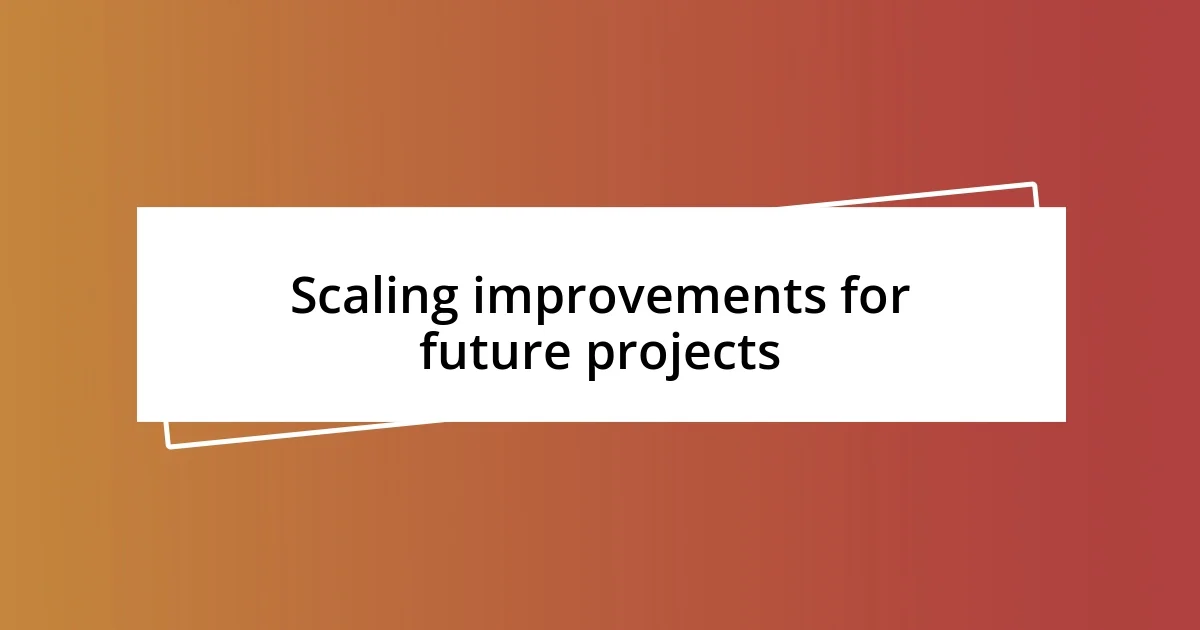Key takeaways:
- Effective communication and proactive questioning with clients enhanced project outcomes, reducing misunderstandings and saving time.
- Implementing agile development techniques, like iterative tasks and daily stand-ups, improved team cohesion and client satisfaction.
- Utilizing automation tools for tasks like testing and documentation significantly streamlined workflows, allowing more focus on creativity and innovation.

Understanding my web development challenges
One of the biggest challenges I faced in web development was time management. I often found myself juggling multiple projects and deadlines, leading to a feeling of constant pressure. Have you ever experienced that overwhelming rush at the last minute? It’s exhausting.
I also struggled with communication, especially when collaborating with clients who had various expectations but didn’t always articulate them clearly. I once spent hours working on a design that was completely off-base, only to realize I hadn’t asked the right questions upfront. That moment taught me the importance of proactive communication—really listening to clients can save so much time and frustration.
Another challenge was keeping up with ever-evolving technology. I remember diving headfirst into a new framework, thinking it would revolutionize my process, only to find myself bogged down by a steep learning curve. How do you maintain your passion when it feels like you’re always playing catch-up? It’s moments like these that can test your commitment to the craft.

Identifying inefficiencies in my process
Identifying inefficiencies in my process was a revelation. As I took a closer look, certain patterns started to emerge. I noticed that I often wasted time on repetitive tasks and missed opportunities to streamline my workflow. For instance, I frequently found myself manually updating documentation after each project, instead of automating these processes. The realization hit me—how many hours had I lost without realizing it?
Here are some inefficiencies I identified:
- Repetitive tasks: Manually entering data into different platforms took precious time.
- Unclear project scopes: Starting projects without a clear scope led to lengthy revisions and scope creep.
- Delayed feedback: Waiting on client feedback often stalled progress and created bottlenecks in my workflow.
- Inconsistent naming conventions: This led to disorganization and difficulty locating files during critical stages.
- Lack of version control: Without proper version management, reverting to earlier stages became a frustrating chore.
By recognizing these obstacles, I began to form a more efficient approach to my development process.

Implementing agile development techniques
Implementing agile development techniques transformed my web development process in unexpected ways. One key aspect I found crucial was the emphasis on iterative development. Instead of delivering a complete project at once, I started breaking tasks into smaller, manageable pieces. I still remember the relief I felt when my client expressed satisfaction during weekly check-ins, allowing for adjustments before the final product was delivered. This not only fostered better communication but boosted my confidence in meeting client expectations along the way.
Another technique that proved beneficial was employing daily stand-up meetings. These quick check-ins may seem insignificant, but they significantly improved my team’s cohesion and accountability. I recall an instance where a simple 15-minute meeting clarified a misunderstanding about project priorities, effectively preventing a potential roadblock. This practice kept us aligned and motivated, ultimately reducing the stress of last-minute surprises that once plagued my projects.
Finally, utilizing user stories helped me view tasks from the client’s perspective. Crafting stories around features reminded me of their real-world application, making my work feel more meaningful. It was enlightening to think about how each line of code impacted actual users. Have you ever had that moment of clarity where everything just clicked? For me, it was this shift in perspective that made my development process agile and much more enjoyable.
| Traditional Development | Agile Development |
|---|---|
| Delivering final product in one go | Delivering in increments for feedback |
| Long development cycles | Short, iterative cycles |
| Unclear scope leading to revisions | Clear prioritized user stories |
| Delayed communication | Frequent check-ins and updates |

Utilizing automation tools effectively
When I dove into automation tools, it felt like flipping a switch that lit up my workflow. Tools like Gulp and Webpack helped automate tasks like minifying my CSS and JavaScript files. I still vividly recall the first time I watched my build process complete in seconds instead of minutes. It’s a simple change, but it transformed how I approached projects, giving me back valuable time to focus on the creative aspects.
Using platforms like Zapier was another game-changer for me. I remember setting up an automation that triggered an email notification every time a new client inquiry landed in my project management tool. This removed the anxiety of missed messages and allowed me to respond swiftly. Have you ever felt that rush of relief when you know nothing is slipping through the cracks? For me, it not only maintained my sanity but also bolstered my professional image.
Integrating testing tools into my daily routine further streamlined my process. I’d automate browser testing through tools like Selenium and quickly generate reports for each build. The first time everything passed without a hitch was like winning a mini-lottery. There’s something immensely satisfying about knowing that tedious tasks are all taken care of. It encourages me to tackle more complex problems head-on, knowing I have the support of automation on my side. So, what tasks could you automate in your workflow that might give you that same feeling of freedom?

Streamlining communication with my team
One of the biggest shifts I made was adopting a communication platform that all team members could access easily. I remember the chaos of tracking messages across emails and different apps—it felt like piecing together a jigsaw puzzle with missing pieces. By centralizing communication through tools like Slack, not only did we reduce confusion, but I also found it easier to keep the conversation on point. It’s amazing how a simple adjustment can clear up so much mental clutter, right?
I also started implementing a feedback loop during our project reviews. Initially, I was hesitant, thinking it might slow us down, but to my surprise, it had the opposite effect. I still recall one meeting where we pinpointed an aspect of design that wasn’t resonating with our clients—our discussion led to a solution that ultimately delighted them. This not only improved our end product but strengthened our team by fostering an environment where everyone felt their voice mattered.
Lastly, I prioritized open channels for informal conversations. I launched “coffee chat” sessions once a week, aiming to build rapport. I vividly remember one of our chats where a team member shared a personal challenge they were facing, which led to deeper connections within the group. It struck me how crucial these informal interactions are—who would have thought that a simple conversation over a cup of coffee could lead to more trust and collaboration among us?

Monitoring and evaluating outcomes
Monitoring the outcomes of my projects has proven to be a cornerstone of my web development process. Whenever I wrapped up a project, I would dedicate time to analyze performance metrics and user feedback. It was eye-opening to realize which features resonated most with users and which ones fell flat. Have you ever reviewed a project only to find hidden gems in data that you hadn’t noticed before? For me, uncovering those insights made all the effort worthwhile, reinforcing that every project is a learning opportunity.
I often use tools like Google Analytics to track user interactions on websites I develop. The first time I noticed a spike in user engagement after implementing changes, I felt a rush of accomplishment. It’s those little victories that reveal the direct impact of my decisions. Through this ongoing evaluation, I can refine my techniques and ensure that I’m meeting—not just the clients’ expectations—but the needs of the end-users.
Setting specific goals before launching a project helps me measure success quantitatively. I remember one particular project where we aimed for a 20% increase in conversions. After three months of monitoring, not only did we meet that goal, we exceeded it by 30%! It was a thrilling moment, confirming that the strategies we implemented were hitting the mark. Isn’t it fascinating how data can become a powerful storytelling tool, illustrating the journey of our projects and the value we deliver?

Scaling improvements for future projects
One of the critical scaling improvements I’ve integrated into future projects is modular development. I started breaking down complex tasks into smaller, manageable components, which has not only streamlined my workflow but also allowed the team to tackle multiple elements simultaneously. I’ll never forget the first time we used this approach on a large project; it felt like unlocking a new level of productivity. Have you ever felt overwhelmed by a big task, only to realize it becomes manageable when divided? This strategy has given my team the flexibility to pivot and adapt without losing momentum.
Additionally, I’ve invested time in refining my documentation process. In past projects, I often relied on my memory to guide the team, which sometimes led to inconsistency and confusion. Now, I document our workflows, coding practices, and design principles meticulously. I remember reviewing an old project guide with a team member and realizing how much smoother our current projects were running because of the clarity provided by these documents. It’s surprising how a comprehensive guide can become a team’s best friend—have you ever wished you had something like that handy?
As I plan for the next wave of projects, I’ve begun incorporating more automation into routine tasks, such as testing and deployment. Initially, I was wary of automating processes since I feared it might complicate things; however, after implementing continuous integration systems, I experienced an exhilarating boost in efficiency. I still recall the freedom I felt after a successful auto-deployment that allowed us to focus on more creative challenges rather than repetitive chores. Aren’t there moments when technology makes our lives infinitely easier? I’ve found that embracing these tools opens up more time for innovation and collaboration.














